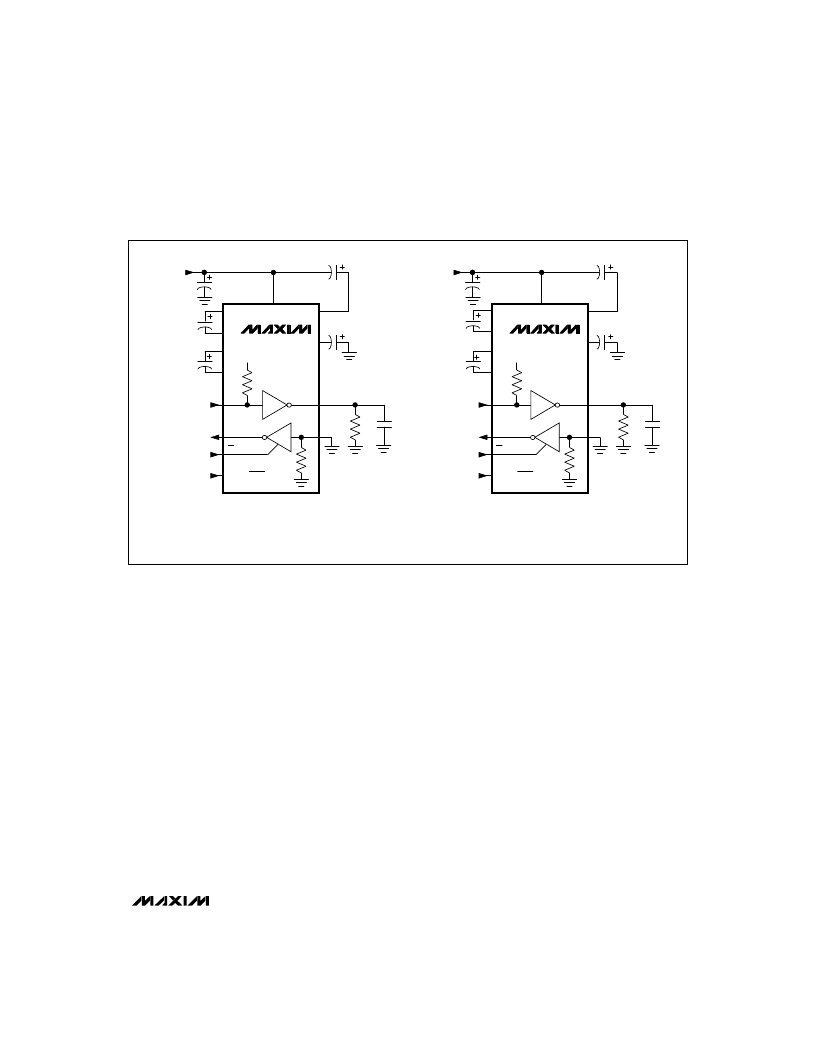- 您現(xiàn)在的位置:買賣IC網(wǎng) > PDF目錄385523 > MAX203E (Maxim Integrated Products, Inc.) ±5kV ESD-Protected, +5V RS-232 Transceivers(5V,120kbps,自關(guān)閉方式, ESD保護(hù),RS-232收發(fā)器) PDF資料下載
參數(shù)資料
| 型號: | MAX203E |
| 廠商: | Maxim Integrated Products, Inc. |
| 英文描述: | ±5kV ESD-Protected, +5V RS-232 Transceivers(5V,120kbps,自關(guān)閉方式, ESD保護(hù),RS-232收發(fā)器) |
| 中文描述: | ±15kV ESD保護(hù)、+5V RS-232收發(fā)器 |
| 文件頁數(shù): | 9/24頁 |
| 文件大?。?/td> | 265K |
| 代理商: | MAX203E |

M
±15kV ESD-Protected, +5V RS-232 Transceivers
_______________________________________________________________________________________
9
V+
MAX2_ _E
0.1μF
*
V
CC
0.1μF
*
T_
R_
0.1μF
*
C1+
C1-
C2+
C2-
V
CC
T_OUT
R_OUT
EN (EN)
SHDN (SHDN)
400k
5k
0.1μF
*
0.1μF
*
3k
+5V
R_IN
T_IN
MINIMUM SLEW-RATE TEST CIRCUIT
0V (+5V)
0V (+5V)
2500pF
V-
V+
0.1μF
*
V
CC
0.1μF
*
R_
T_
0.1μF
*
C1+
C1-
C2+
C2-
V
CC
T_OUT
R_OUT
EN (EN)
SHDN (SHDN)
400k
5k
0.1μF
*
0.1μF
*
7k
+5V
R_IN
T_IN
MAXIMUM SLEW-RATE TEST CIRCUIT
0V (+5V)
0V (+5V)
50pF
V-
( ) ARE FOR MAX213E
* 1
μ
F FOR MAX232E/MAX241E
MAX2_ _E
TRANSMITTER INPUT PULL-UP RESISTORS, ENABLE, AND SHUTDOWN ARE NOT PROVIDED ON THE MAX202E, MAX203E, AND MAX232E.
ENABLE AND SHUTDOWN ARE NOT PROVIDED ON THE MAX207E AND MAX208E.
Figure 3. Transition Slew-Rate Circuit
_______________Detailed Desc ription
The MAX202E–MAX213E, MAX232E/MAX241E consist of
three sections: charge-pump voltage converters,
drivers (transmitters), and receivers. These E versions
provide extra protection against ESD. They survive
±15kV discharges to the RS-232 inputs and outputs,
tested using the Human Body Model. When tested
according to IEC1000-4-2, they survive ±8kV contact-
discharges and ±15kV air-gap discharges. The rugged
E versions are intended for use in harsh environments
or applications where the RS-232 connection is
frequently changed (such as notebook computers). The
standard (non-“E”) MAX202, MAX203, MAX205–
MAX208, MAX211, MAX213, MAX232, and MAX241 are
recommended for applications where cost is critical.
+5V to ±10V Dual Charge-Pump
V oltage Converter
The +5V to ±10V conversion is performed by dual
charge-pump voltage converters (Figure 4). The first
charge-pump converter uses capacitor C1 to double
the +5V into +10V, storing the +10V on the output filter
capacitor, C3. The second uses C2 to invert the +10V
into -10V, storing the -10V on the V- output filter
capacitor, C4.
In shutdown mode, V+ is internally connected to V
CC
by
a 1k
pull-down resistor, and V- is internally connected
to ground by a 1k
pull-up resistor.
RS -232 Drivers
With V
CC
= 5V, the typical driver output voltage swing
is ±8V when loaded with a nominal 5k
RS-232
receiver. The output swing is guaranteed to meet
EIA/TIA-232E and V.28 specifications that call for ±5V
minimum output levels under worst-case conditions.
These include a 3k
load, minimum V
C C
, and
maximum operating temperature. The open-circuit
output voltage swings from (V+ - 0.6V) to V-.
Input thresholds are CMOS/TTL compatible. The
unused drivers’ inputs on the MAX205E–MAX208E,
MAX211E, MAX213E, and MAX241E can be left
unconnected because 400k
pull-up resistors to V
CC
are included on-chip. Since all drivers invert, the pull-
up resistors force the unused drivers’ outputs low. The
MAX202E, MAX203E, and MAX232E do not have pull-
up resistors on the transmitter inputs.
相關(guān)PDF資料 |
PDF描述 |
|---|---|
| MAX2100 | Quadrature Digitizer Circuits(正交數(shù)字轉(zhuǎn)換器電路) |
| MAX2102EVKIT-SO | Evaluation Kit |
| MAX2140EVKIT | Evaluation Kit |
| MAX2160_1 | Evaluation Kit |
| MAX2160 | Evaluation Kit |
相關(guān)代理商/技術(shù)參數(shù) |
參數(shù)描述 |
|---|---|
| MAX203ECPP | 功能描述:RS-232接口集成電路 RoHS:否 制造商:Exar 數(shù)據(jù)速率:52 Mbps 工作電源電壓:5 V 電源電流:300 mA 工作溫度范圍:- 40 C to + 85 C 安裝風(fēng)格:SMD/SMT 封裝 / 箱體:LQFP-100 封裝: |
| MAX203ECPP+ | 制造商:Maxim Integrated Products 功能描述:Dual Transmitter/Receiver RS-232 20-Pin PDIP N Bulk |
| MAX203ECPP+G36 | 功能描述:RS-232接口集成電路 15kV ESD-Protected 5V RS232 Transceiver RoHS:否 制造商:Exar 數(shù)據(jù)速率:52 Mbps 工作電源電壓:5 V 電源電流:300 mA 工作溫度范圍:- 40 C to + 85 C 安裝風(fēng)格:SMD/SMT 封裝 / 箱體:LQFP-100 封裝: |
| MAX203ECWP | 功能描述:RS-232接口集成電路 RoHS:否 制造商:Exar 數(shù)據(jù)速率:52 Mbps 工作電源電壓:5 V 電源電流:300 mA 工作溫度范圍:- 40 C to + 85 C 安裝風(fēng)格:SMD/SMT 封裝 / 箱體:LQFP-100 封裝: |
| MAX203ECWP+ | 制造商:Maxim Integrated Products 功能描述:Dual Transmitter/Receiver RS-232 20-Pin SOIC W Bulk 制造商:Maxim Integrated Products 功能描述:TRANSCEIVER DUAL RS232 SMD SOIC20 制造商:Maxim Integrated Products 功能描述:TRANSCEIVER DUAL RS232, SMD, SOIC20 |
發(fā)布緊急采購,3分鐘左右您將得到回復(fù)。